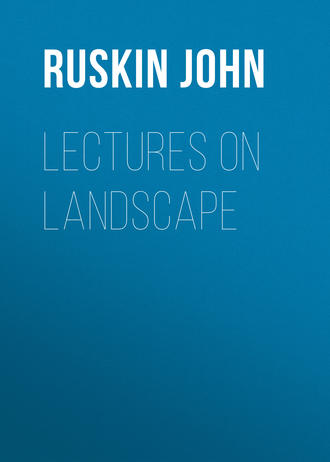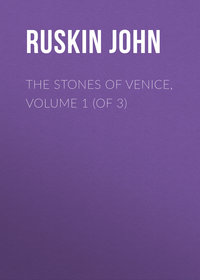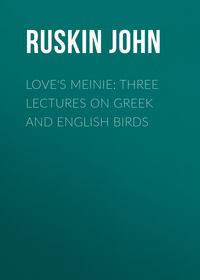 полная версия
полная версияLectures on Landscape
78. Now for your own practice in this, having first acquired the skill of exquisite delineation and laying of pure color, day by day you must draw some lovely natural form or flower or animal without obscurity—as in missal painting; choosing for study, in natural scenes, only what is beautiful and strong in life.
79. I fully anticipated, at the beginning of the Pre-Raphaelite movement, that they would have carried forward this method of work; but they broke themselves to pieces by pursuing dramatic sensation instead of beauty. So that to this day all the loveliest things in the world remain unpainted; and although we have occasionally spasmodic efforts and fits of enthusiasm, and green meadows and apple-blossom to spare, it yet remains a fact that not in all this England, and still less in France, have you a painter who has been able nobly to paint so much as a hedge of wild roses or a forest glade full of anemones or wood-sorrel.
80. One reason of this has been the idea that such work was easy, on the part of the young men who attempted it, and the total vulgarity and want of education in the great body of abler artists, rendering them insensitive to qualities of fine delineation; the universal law for them being that they can draw a pig, but not a Venus. For instance, two landscape-painters of much reputation in England, and one of them in France also—David Cox and John Constable, represent a form of blunt and untrained faculty which in being very frank and simple, apparently powerful, and needing no thought, intelligence or trouble whatever to observe, and being wholly disorderly, slovenly and licentious, and therein meeting with instant sympathy from the disorderly public mind now resentful of every trammel and ignorant of every law—these two men, I say, represent in their intensity the qualities adverse to all accurate science or skill in landscape art; their work being the mere blundering of clever peasants, and deserving no name whatever in any school of true practice, but consummately mischievous—first, in its easy satisfaction of the painter's own self-complacencies, and then in the pretense of ability which blinds the public to all the virtue of patience and to all the difficulty of precision. There is more real relation to the great schools of art, more fellowship with Bellini and Titian, in the humblest painter of letters on village signboards than in men like these.
Do not, therefore, think that the Gothic school is an easy one. You might more easily fill a house with pictures like Constable's from garret to cellar, than imitate one cluster of leaves by Van Eyck or Giotto; and among all the efforts that have been made to paint our common wild-flowers, I have only once—and that in this very year, just in time to show it to you—seen the thing done rightly.
81. But now observe: These flowers, beautiful as they are, are not of the Gothic school. The law of that school is that everything shall be seen clearly, or at least, only in such mist or faintness as shall be delightful; and I have no doubt that the best introduction to it would be the elementary practice of painting every study on a golden ground. This at once compels you to understand that the work is to be imaginative and decorative; that it represents beautiful things in the clearest way, but not under existing conditions; and that, in fact, you are producing jeweler's work, rather than pictures. Then the qualities of grace in design become paramount to every other; and you may afterwards substitute clear sky for the golden background without danger of loss or sacrifice of system: clear sky of golden light, or deep and full blue, for the full blue of Titian is just as much a piece of conventional enameled background as if it were a plate of gold; that depth of blue in relation to foreground objects being wholly impossible.
82. There is another immense advantage in this Byzantine and Gothic abstraction of decisive form, when it is joined with a faithful desire of whatever truth can be expressed on narrow conditions. It makes us observe the vital points in which character consists, and educates the eye and mind in the habit of fastening and limiting themselves to essentials. In complete drawing, one is continually liable to be led aside from the main points by picturesque accidents of light and shade; in Gothic drawing you must get the character, if at all, by a keenness of analysis which must be in constant exercise.
83. And here I must beg of you very earnestly, once for all, to clear your minds of any misapprehension of the nature of Gothic art, as if it implied error and weakness, instead of severity. That a style is restrained or severe does not mean that it is also erroneous. Much mischief has been done—endless misapprehension induced in this matter—by the blundering religious painters of Germany, who have become examples of the opposite error from our English painters of the Constable group. Our uneducated men work too bluntly to be ever in the right; but the Germans draw finely and resolutely wrong. Here is a "Riposo" of Overbeck's for instance, which the painter imagined to be elevated in style because he had drawn it without light and shade, and with absolute decision: and so far, indeed, it is Gothic enough; but it is separated everlastingly from Gothic and from all other living work, because the painter was too vain to look at anything he had to paint, and drew every mass of his drapery in lines that were as impossible as they were stiff, and stretched out the limbs of his Madonna in actions as unlikely as they are uncomfortable.
In all early Gothic art, indeed, you will find failure of this kind, especially distortion and rigidity, which are in many respects painfully to be compared with the splendid repose of classic art. But the distortion is not Gothic; the intensity, the abstraction, the force of character are, and the beauty of color.
84. Here is a very imperfect, but illustrative border of flowers and animals on a golden ground. The large letter contains, indeed, entirely feeble and ill-drawn figures: that is merely childish and failing work of an inferior hand; it is not characteristic of Gothic, or any other school. But this peacock, being drawn with intense delight in blue, on gold, and getting character of peacock in the general sharp outline, instead of—as Rubens' peacocks—in black shadow, is distinctively Gothic of fine style.
85. I wish you therefore to begin your study of natural history and landscape by discerning the simple outlines and the pleasant colors of things; and to rest in them as long as you can. But, observe, you can only do this on one condition—that of striving also to create, in reality, the beauty which you seek in imagination. It will be wholly impossible for you to retain the tranquillity of temper and felicity of faith necessary for noble purist painting, unless you are actively engaged in promoting the felicity and peace of practical life. None of this bright Gothic art was ever done but either by faith in the attainableness of felicity in heaven, or under conditions of real order and delicate loveliness on the earth.
86. As long as I can possibly keep you among them, there you shall stay—among the almond and apple blossom. But if you go on into the veracities of the school of Clay, you will find there is something at the roots of almond and apple trees, which is—This. You must look at him in the face—fight him—conquer him with what scathe you may: you need not think to keep out of the way of him. There is Turner's Dragon; there is Michael Angelo's; there, a very little one of Carpaccio's. Every soul of them had to understand the creature, and very earnestly.
87. Not that Michael Angelo understands his dragon as the others do. He was not enough a colorist either to catch the points of the creature's aspect, or to feel the same hatred of them; but I confess myself always amazed in looking at Michael Angelo's work here or elsewhere, at his total carelessness of anatomical character except only in the human body. It is very easy to round a dragon's neck, if the only idea you have of it is that it is virtually no more than a coiled sausage; and, besides, anybody can round anything if you have full scale from white high light to black shadow.
88. But look here at Carpaccio, even in my copy. The colorist says, "First of all, as my delicious paroquet was ruby, so this nasty viper shall be black"; and then is the question, "Can I round him off, even though he is black, and make him slimy, and yet springy, and close down—clotted like a pool of black blood on the earth—all the same?" Look at him beside Michael Angelo's, and then tell me the Venetians can't draw! And also, Carpaccio does it with a touch, with one sweep of his brush; three minutes at the most allowed for all the beast; while Michael Angelo has been haggling at this dragon's neck for an hour.
89. Then note also in Turner's that clinging to the earth—the specialty of him—il gran nemico, "the great enemy," Plutus. His claws are like the Clefts of the Rock; his shoulders like its pinnacles; his belly deep into its every fissure—glued down—loaded down; his bat's wings cannot lift him, they are rudimentary wings only.
90. Before I tell you what he means himself, you must know what all this smoke about him means.
Nothing will be more precious to you, I think, in the practical study of art, than the conviction, which will force itself on you more and more every hour, of the way all things are bound together, little and great, in spirit and in matter. So that if you get once the right clue to any group of them, it will grasp the simplest, yet reach to the highest truths. You know I have just been telling you how this school of materialism and clay involved itself at last in cloud and fire. Now, down to the least detail of method and subject, that will hold.
91. Here is a perfect type, though not a complex one, of Gothic landscape; the background gold, the trees drawn leaf by leaf, and full green in color—no effect of light. Here is an equally typical Greek-school landscape, by Wilson—lost wholly in golden mist; the trees so slightly drawn that you don't know if they are trees or towers, and no care for color whatever; perfectly deceptive and marvelous effect of sunshine through the mist—"Apollo and the Python." Now here is Raphael, exactly between the two—trees still drawn leaf by leaf, wholly formal; but beautiful mist coming gradually into the distance. Well, then, last, here is Turner's; Greek-school of the highest class; and you define his art, absolutely, as first the displaying intensely, and with the sternest intellect, of natural form as it is, and then the envelopment of it with cloud and fire. Only, there are two sorts of cloud and fire. He knows them both. There's one, and there's another—the "Dudley" and the "Flint." That's what the cloud and flame of the dragon mean: now, let me show you what the dragon means himself.
92. I go back to another perfect landscape of the living Gothic school. It is only a pencil outline, by Edward Burne-Jones, in illustration of the story of Psyche; it is the introduction of Psyche, after all her troubles, into heaven.
Now in this of Burne-Jones, the landscape is clearly full of light everywhere, color or glass light: that is, the outline is prepared for modification of color only. Every plant in the grass is set formally, grows perfectly, and may be realized completely. Exquisite order, and universal, with eternal life and light, this is the faith and effort of the schools of Crystal; and you may describe and complete their work quite literally by taking any verses of Chaucer in his tender mood, and observing how he insists on the clearness and brightness first, and then on the order. Thus, in Chaucer's "Dream":
"Within an yle me thought I was,Where wall and yate was all of glasse,And so was closed round aboutThat leavelesse none come in ne out,Uncouth and straunge to beholde,For every yate of fine goldeA thousand fanes, aie turning,Entuned had, and briddes singingDivers, and on each fane a paireWith open mouth again here;And of a sute were all the touresSubtily corven after floures,Of uncouth colors during ayeThat never been none seene in May."93. Next to this drawing of Psyche I place two of Turner's most beautiful classical landscapes. At once you are out of the open daylight, either in sunshine admitted partially through trembling leaves, or in the last rays of its setting, scarcely any more warm on the darkness of the ilex wood. In both, the vegetation, though beautiful, is absolutely wild and uncared for, as it seems, either by human or by higher powers, which, having appointed for it the laws of its being, leave it to spring into such beauty as is consistent with disease and alternate with decay.

ÆSACUS AND HESPERIE.
From the painting by Turner.
In the purest landscape, the human subject is the immortality of the soul by the faithfulness of love: in both the Turner landscapes it is the death of the body by the impatience and error of love. The one is the first glimpse of Hesperia to Æsacus:13
"Aspicit Hesperien patria Cebrenida ripa,Injectos humeris siccantem sole capillos:"in a few moments to lose her forever. The other is a mythological subject of deeper meaning, the death of Procris.
94. I just now referred to the landscape by John Bellini in the National Gallery as one of the six best existing of the purist school, being wholly felicitous and enjoyable. In the foreground of it indeed is the martyrdom of Peter Martyr; but John Bellini looks upon that as an entirely cheerful and pleasing incident; it does not disturb or even surprise him, much less displease in the slightest degree.
Now, the next best landscape14 to this, in the National Gallery, is a Florentine one on the edge of transition to the Greek feeling; and in that the distance is still beautiful, but misty, not clear; the flowers are still beautiful, but—intentionally—of the color of blood; and in the foreground lies the dead body of Procris, which disturbs the poor painter greatly; and he has expressed his disturbed mind about it in the figure of a poor little brown—nearly black—Faun, or perhaps the god Faunus himself, who is much puzzled by the death of Procris, and stoops over her, thinking it a woeful thing to find her pretty body lying there breathless, and all spotted with blood on the breast.
95. You remember I told you how the earthly power that is necessary in art was shown by the flight of Dædalus to the 'ερπετον Minos. Look for yourselves at the story of Procris as related to Minos in the fifteenth chapter of the third book of Apollodorus; and you will see why it is a Faun who is put to wonder at her, she having escaped by artifice from the Bestial power of Minos. Yet she is wholly an earth-nymph, and the son of Aurora must not only leave her, but himself slay her; the myth of Semele desiring to see Zeus, and of Apollo and Coronis, and this having all the same main interest. Once understand that, and you will see why Turner has put her death under this deep shade of trees, the sun withdrawing his last ray; and why he has put beside her the low type of an animal's pain, a dog licking its wounded paw.
96. But now, I want you to understand Turner's depth of sympathy farther still. In both these high mythical subjects the surrounding nature, though suffering, is still dignified and beautiful. Every line in which the master traces it, even where seemingly negligent, is lovely, and set down with a meditative calmness which makes these two etchings capable of being placed beside the most tranquil work of Holbein or Dürer. In this "Cephalus" especially, note the extreme equality and serenity of every outline. But now here is a subject of which you will wonder at first why Turner drew it at all. It has no beauty whatsoever, no specialty of picturesqueness; and all its lines are cramped and poor.
The crampness and the poverty are all intended. This is no longer to make us think of the death of happy souls, but of the labor of unhappy ones; at least, of the more or less limited, dullest, and—I must not say homely, but—unhomely life of the neglected agricultural poor.
It is a gleaner bringing down her one sheaf of corn to an old watermill, itself mossy and rent, scarcely able to get its stones to turn. An ill-bred dog stands, joyless, by the unfenced stream; two country boys lean, joyless, against a wall that is half broken down; and all about the steps down which the girl is bringing her sheaf, the bank of earth, flowerless and rugged, testifies only of its malignity; and in the black and sternly rugged etching—no longer graceful, but hard, and broken in every touch—the master insists upon the ancient curse of the earth—"Thorns also and Thistles shall it bring forth to thee."
97. And now you will see at once with what feeling Turner completes, in a more tender mood, this lovely subject of his Yorkshire stream, by giving it the conditions of pastoral and agricultural life; the cattle by the pool, the milkmaid crossing the bridge with her pail on her head, the mill with the old millstones, and its gleaming weir as his chief light led across behind the wild trees.

MILL NEAR GRANDE CHARTREUSE.
From the painting by Turner.
98. And not among our soft-flowing rivers only; but here among the torrents of the Great Chartreuse, where another man would assuredly have drawn the monastery, Turner only draws their working mill. And here I am able to show you, fortunately, one of his works painted at this time of his most earnest thought; when his imagination was still freshly filled with the Greek mythology, and he saw for the first time with his own eyes the clouds come down upon the actual earth.

L'AIGUILLETTE, VALLEY OF CLUSES.
From the painting by Turner.
99. The scene is one which, in old times of Swiss traveling, you would all have known well; a little cascade which descends to the road from Geneva to Chamouni, near the village of Maglans, from under a subordinate ridge of the Aiguille de Varens, known as the Aiguillette. You, none of you, probably, know the scene now; for your only object is to get to Chamouni and up Mont Blanc and down again; but the Valley of Cluse, if you knew it, is worth many Chamounis; and it impressed Turner profoundly. The facts of the spot are here given in mere and pure simplicity; a quite unpicturesque bridge, a few trees partly stunted and blasted by the violence of the torrent in storm at their roots, a cottage with its mill-wheel—this has lately been pulled down to widen the road—and the brook shed from the rocks and finding its way to join the Arve. The scene is absolutely Arcadian. All the traditions of the Greek Hills, in their purity, were founded on such rocks and shadows as these; and Turner has given you the birth of the Shepherd Hermes on Cyllene, in its visible and solemn presence, the white cloud, Hermes Eriophoros forming out of heaven upon the Hills; the brook, distilled from it, as the type of human life, born of the cloud and vanishing into the cloud, led down by the haunting Hermes among the ravines; and then, like the reflection of the cloud itself, the white sheep, with the dog of Argus guarding them, drinking from the stream.
100. And now, do you see why I gave you, for the beginning of your types of landscape thought, that "Junction of Tees and Greta" in their misty ravines; and this glen of the Greta above, in which Turner has indeed done his best to paint the trees that live again after their autumn—the twilight that will rise again with twilight of dawn—the stream that flows always, and the resting on the cliffs of the clouds that return if they vanish; but of human life, he says, a boy climbing among the trees for his entangled kite, and these white stones in the mountain churchyard, show forth all the strength and all the end.
101. You think that saying of the Greek school—Pindar's summary of it, "τι δε τις; τι δ'ου τις;"15—a sorrowful and degrading lesson. See at least, then, that you reach the level of such degradation. See that your lives be in nothing worse than a boy's climbing for his entangled kite. It will be well for you if you join not with those who instead of kites fly falcons; who instead of obeying the last words of the great Cloud-Shepherd—to feed his sheep, live the lives—how much less than vanity!—of the war-wolf and the gier-eagle. Or, do you think it a dishonor to man to say to him that Death is but only Rest? See that when it draws near to you, you may look to it, at least for sweetness of Rest; and that you recognize the Lord of Death coming to you as a Shepherd gathering you into his Fold for the night.
1
"Lectures on Art, 1870," § 23.
2
National Gallery, No. 812.
3
Make a note of these points:
1. Date, time of day, temperature, direction and force of wind.
2. Roughly, by compass, the direction in which you are looking; and angle of the light with respect to it.
3. Angle subtended by picture, and distance of nearest object in it.
4
From a "Picturesque Tour from Geneva to Milan" … engraved from designs by J. Lory of Neufchâtel. London: Published by R. Ackermann, at his Repository of Arts, 1820.
5
"Lectures on Art, 1870," § 130.
6
At the Ruskin Drawing School, Oxford.
7
"Lectures on Art, 1870," § 170.
8
"Othello," I. 2.
9
"Lectures on Art" (the Inaugural Course, 1870), § 138.
10
Now in the National Gallery, No. 1034.
11
"Lectures on Art, 1870," § 185.
12
No. 812. "Landscape, with the Death of St. Peter Martyr."
13
Ovid, "Metamorphoses," XI. 769.
14
(Of the Purist school.)
15
Pyth. viii. 95. (135.)











